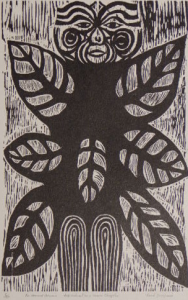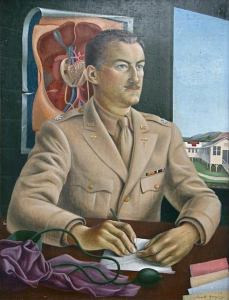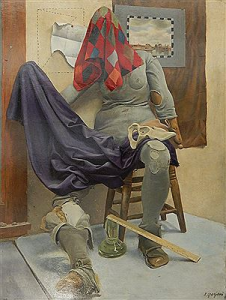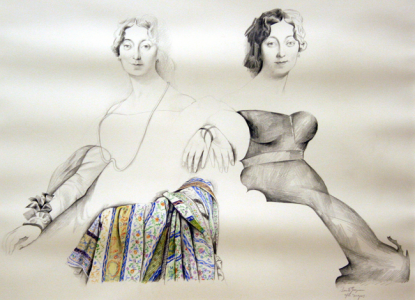
Biography
Race car driver, tennis buff, classical musician and, yes, also an artist. That was Sante Graziano, born to Tuscan immigrant parents in Cleveland, OH in 1920. He attended the Cleveland Institute of Art, where his "Self Portrait" won the senior competition in 1941. The prize money enabled him to go to the Yale School of Art and Architecture, from which he received a Bachelor of Fine Arts degree in 1943.
By that time he had already completed two Post Office murals: "Joseph Deford and His Friends Build the First Cabin in Bluffton" in Bluffton, OH (1941) and "Lovers Leap" in Columbus Junction, IA (1942). He received a Pulitzer traveling scholarship in 1942, and his work was included in the "Artists for Victory" exhibit at the Metropolitan Museum of Art in 1942-1943.
From 1943-1946 Graziani served as the Officer in Charge of Arts and Crafts in the Pacific Theater of Operations, where he work included the preparation of medical drawings and surgical illustrations. It was during this period that he painted the portrait "Army Doctor." He also met his future wife Jacquelee McMurry during the war. They were married after the war and had three children: Michael John (b.1946), Alexandra (b.1954) and Gregory Philip (b.1958).
At the war's end Graziani curated a major exhibit at the Imperial Museum in Tokyo. He completed a mural "The Arts" for the Museum of Fine Arts in Springfield, MA. He had won the commission for this work in a nationwide competition back in 1942, but execution was delayed by the war. Graziani received a Master of Fine Arts degree from Yale in 1948. During the years 1946-1951 he taught at the Yale School of Art, where his colleagues included Josef Albers and Willem De Kooning, and his students included Claes Oldenburg.
In 1950-1951 Graziani was Dean of the Whitney School of Art in New Haven. And he taught at the School of the Worcester Art Museum in Worcester, MA from 1951-1981, eventually serving as Dean of the School. In 1954 he completed a series of murals for the Holyoke Public Library, depicting the history of Holyoke.
Graziani's murals were mostly in the style of the American Scene. Indeed he described his art education as having been focused on the "Holy Trinity" of Thomas Hart Benton, Grant Wood and John Steuart Curry. But his easel paintings delved into other styles, including surrealism and paintings that incorporated images from famous paintings of the past. He created a pop art sort of mural, the "Wall O' Washingtons" in Worcester in 1976.
In 1980 the United States Postal Service commissioned Graziani to create a commemorative stamp entitled "Philip Mazzei: Patriot Remembered." In 1982 Graziani moved to Hamden, CT, where he served as Dean of the Paier College of Art from 1982-1995, becoming Dean Emeritus in 1995. His last mural work was for the Shubert Theater in New Haven in 1997. He died in Princeton, MA in 2005.
Graziani maintained his physical condition throughout his life, playing tennis into his 80s. He also loved daredevil activities such as driving open-wheel race cars and Italian motorcycles. Meanwhile he played the violin, viola and cello in symphony orchestras across Southern Connecticut.



Critical Analysis
The design of Graziani's murals owed much to the great Mexican muralists Diego Rivera, José Clemente Orozco, and David Alfaro Siqueiros. But instead of the revolutionary subject matter that these artists favored, Graziani chose as his topics the gentler material of the American Scene. He had a technical mastery of mural art and a sense of design that gave great impact to his work.
During Graziani's time at the School of the Worcester Art Museum, he painted a lot of pop art, showing an impish sense of humor, as in his "Wall O' Washingtons" mural. His subject matter went through several phases, first verging into surrealism and later making a homage to classical subjects, by incorporating their images into his paintings. Here again Graziani's humor helped carry the day.
Murals
- Columbus Junction, Iowa - Post Office: Lover's Leap
- Springfield, Massachusetts - Michele and Donald D'Amour Museum of Fine Arts: The Arts
- Bluffton, Ohio - Post Office: Joseph DeFord and His Friends Building the First Cabin
References
- Stefan C. Schatzki, Army Doctor, American Journal of Roentgenology Volume 197, Issue 2, August (2011).
- Art dean was a Renaissance man with passion for living a full life, New Haven Register March 25 (2005).
- Sante Graziani (Wikipedia).
- Sante Graziani (Prabook).